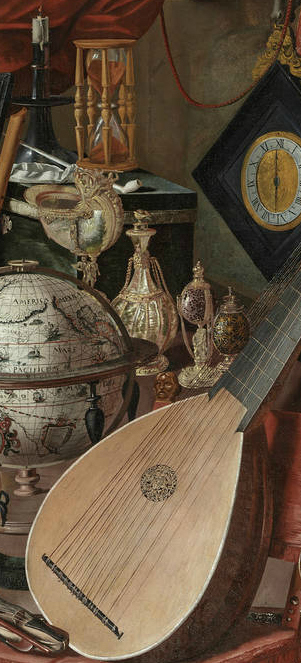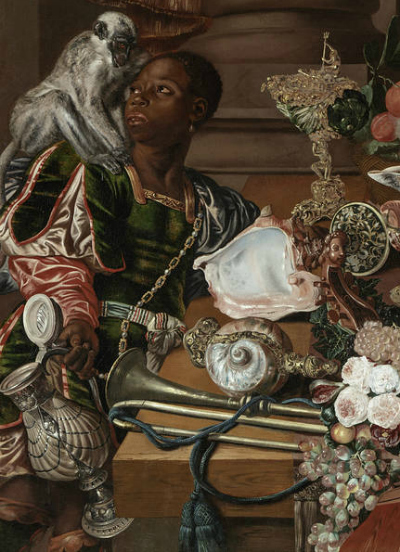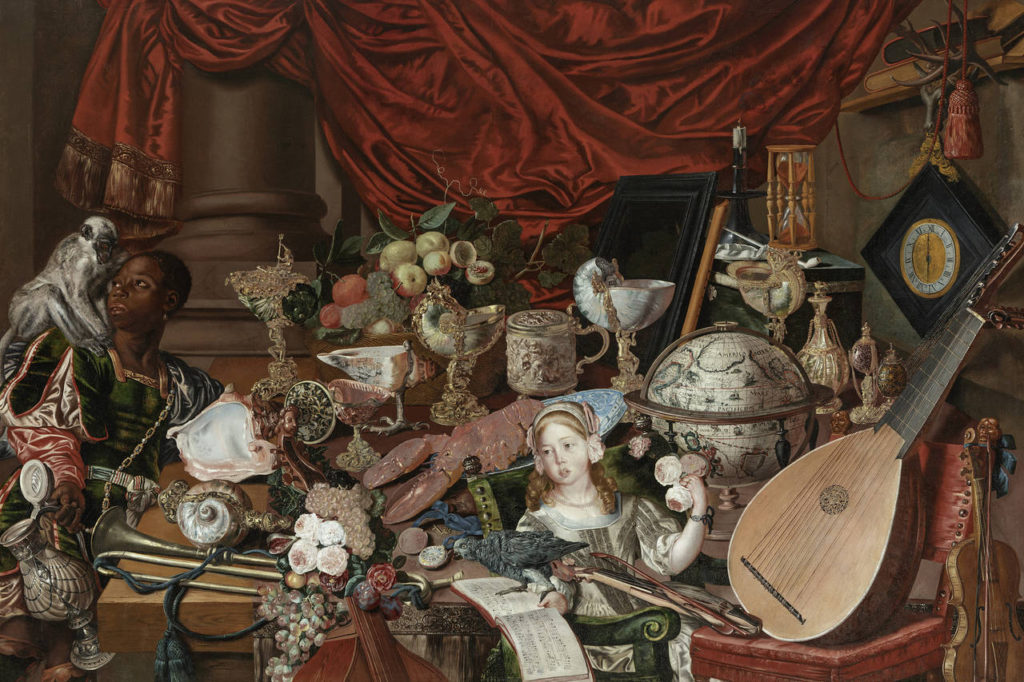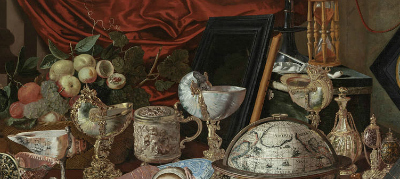 I’ll bet most, if not all, of you have never heard of a large painting called The Paston Treasure, c. 1663. Neither had I, until I saw a little picture of this 8 feet by 5.4 feet work. As I guess then, it’s a real gem, a unique painting in more than one way. It’s now on view at the Yale Center for British Art–and worth the trip if you are anywhere nearby.
I’ll bet most, if not all, of you have never heard of a large painting called The Paston Treasure, c. 1663. Neither had I, until I saw a little picture of this 8 feet by 5.4 feet work. As I guess then, it’s a real gem, a unique painting in more than one way. It’s now on view at the Yale Center for British Art–and worth the trip if you are anywhere nearby.
The painting–detail at left (and elsewhere) and pasted just below–probably by an unknown Dutch itinerant painter, anchors an excellent exhibition. But I chose to write about the painting itself in The Wall Street Journal‘s Masterpiece column, what was published last Saturday (I know, I know–but I’ve been really busy). The headline and deck were A Painting Framed in Mystery: ‘The Paston Treasure’ flaunts a family’s wealth while meditating on death.
First, here’s the “nut graf(s)”:
It looks like an overstuffed jumble, replete with vessels, timepieces, musical instruments, animals, fruits, flowers and more, gathered from the West Indies, Southeast Asia, the South Pacific, Africa and the Americas, as well as Europe. But all these possessions—which would have been on display at the Pastons’ seat, Oxnead Hall, or kept in a locked cabinet of curiosities known as the “best closet”—represent a “microcosm of the known world.”
…The painting is a unique combination of still life, ostentatious banquet painting, allegory of the senses and continents, portraiture, animal painting and—most of all—the vanitas genre. Beneath the bounty is a message: That drooping flower, the ripe fruit, the candle stub convey the fragility of life and inevitability of death. Other objects allude to the fleeting nature of fortune,…
You can read the rest online–how it is a microcosm of the then-known world, in many ways–but there is more to say about this painting and its owners than 800 or so words can contain. A few more bits:
- The Pastons are famous for another reason. Between 1440 and 1509, they wrote hundreds of letters, which survive as one of the largest personal archives of the 15th century now held by the British Library.
- The exhibit includes five objects that are in the painting–a pair of silver-gilt flagons, a Strombus shell cup, two nautilus cups and a c. 1660s perfume flask that was made of mother-of pearl sections imported from India that were joined together by silver-gilt cagework, embellished with chains, given a stopper adorned by a gilt shell–all done in London.
- Those flagons, now in the collection of the Met, were once owned by William Randolph Hearst.
 One thing I had no room to mention: the Paston treasure includes some stock images, like that lobster, along with real objects owned by the Pastons. This has led art historians to suggest that the unknown artist, now called the Master of the Paston Treasure, may be the artist who created a painting in the show titled Monkeys and Parrots, which was discovered in the research phase of this exhibition in a New York collection. That painting has been attributed to Carstian Luyckx or his circle. But there is, apparently, nothing to suggest that Luyckx was ever near Oxnead, in Norwich, where the Treasure was painted (there is documentation for that). More mystery!
One thing I had no room to mention: the Paston treasure includes some stock images, like that lobster, along with real objects owned by the Pastons. This has led art historians to suggest that the unknown artist, now called the Master of the Paston Treasure, may be the artist who created a painting in the show titled Monkeys and Parrots, which was discovered in the research phase of this exhibition in a New York collection. That painting has been attributed to Carstian Luyckx or his circle. But there is, apparently, nothing to suggest that Luyckx was ever near Oxnead, in Norwich, where the Treasure was painted (there is documentation for that). More mystery!- Parts of the paintings are faded–that lobster was red–and this may have been exacerbated by the Pastons themselves. Sir Robert was something of an alchemist, as was his daughter Margaret–also explored in the exhibit–and some pigments were developed to family specifications. They have not fared well.
- The Pastons’ wealth declined and their treasures were sold off within two generations of this painting’s date–that’s why the objects are now so widely dispersed.
There is so much more to explore in this paintings and this exhibition, which won’t come around again. When it closes on May 27, the painting goes back to Norwich Castle Museum & Art Gallery and the objects return to their current owners. That’s why I say, go.
Photo credits: Courtesy of the YCBA


